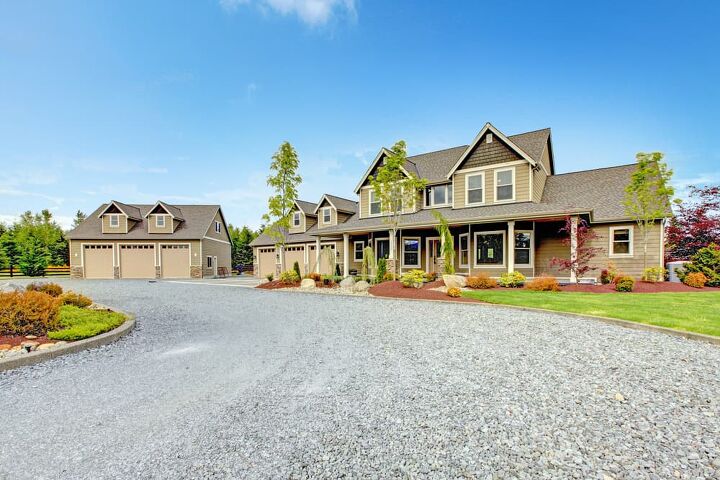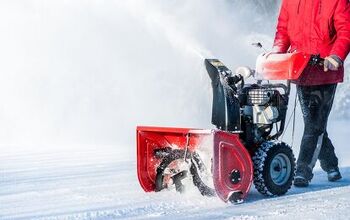How To Keep Gravel In Place In A Driveway (Do This!)

Gravel driveways look great and can add a rustic touch to any home. In areas known for high snowfall or rainfall, they also can add an extra layer of grip. This makes them great for places that have inclement weather, as well as farmhouses. Of course, there is a pretty annoying side effect that you have to deal with: keeping the gravel in your driveway in place.
There are several ways to make sure that your gravel doesn’t escape. The best methods that you can use include:
- Choosing The Right Gravel
- Packing And Tamping
- Adding A Barrier
- Adding More Gravel
- Sloping Areas Near The Driveway
Having a little extra grip on your gravel can help prevent turning your driveway into a mess that stretches all over the lawn. A little knowledge on how to corral all those loose rocks can help you make your yard a lot neater…
Do You Need Gravel and Loose Paving Installation or Repair?
Get free, zero-commitment quotes from pro contractors near you.

How To Keep Gravel In Place On Driveway
Rocks have an amazing way of getting into places they shouldn’t, which is why many people have a hard time with gravel driveways. However, that doesn’t have to be the case. There are a bunch of ways to keep your gravel locked in place. Check out what the research says about the best methods below!
Choose The Right Gravel
It comes as no surprise to anyone that gravel choice can play a role in the ease of keeping things in place. Larger stones are less likely to travel. The same can be said about “raw” gravel that hasn’t been tumbled. With that said, this is a hit-or-miss type of project. Your best bet on finding good gravel is to talk to a gravel supplier about your options.
Packing And Tamping
Packing and tamping is a multi-pronged approach, and this doesn’t just allude to packing down gravel, either. Sometimes the reason why gravel keeps getting into other nooks and crannies is just because it’s loose on the soil. To see if this is the issue, wet down your gravel driveway. Like, really saturate it.
Then, use a tamping tool to pack it all in. Rake it all up and keep tamping it down. You should have a flat-ish gravel driveway when you’re done with this.
Add A Barrier
To a point, adding a gravel grid paving system is one of the most efficient ways to keep your gravel inside. A grid paving system is a carpet-like device that you roll out underneath the gravel. Most of the time, people add this grid system while they’re making their gravel driveway.
If you already have a driveway, things might get a little more difficult. In this case, you can roll it on top and try to push the edges around the gravel. Once you have a grid system in place, add more gravel and then use a shovel to pack it down. The extra gravel, mixed in with the grid, will give you one of the best ways to keep your rocks in place.
Don’t have a paving system? Sometimes, you can actually get a decent barrier by just laying out two by fours along the sides of your driveway, digging at the edges, and dropping them in. However, this is not always as effective. It’s still worth a shot, though.
Add More Gravel
Sometimes, it’s not a matter of having a barrier or anything else. Sometimes, it’s really just a matter of not having enough gravel to give your driveway a full look. Having a thicker layer of gravel is a surprisingly easy way to compact your driveway. The weight of gravel actually compacts the gravel underneath it as long as you have at least three inches of the stuff up there.
If you have small-sized pebble gravel, this is going to be the most effective way to make sure that your gravel is properly tamped down without actually tamping anything down.
Sloping
Gravel doesn’t have an exception to the rules of gravity and physics. If you “cradle” the gravel by adding extra soil to the outside edges of your driveway, it will be harder for the gravel to escape your driveway. It’s a lot like putting your gravel in a bowl. By having your driveway sloped downwards near the gravel area, your gravel will be forced to stay in place.
Admittedly, this can do a number on your lawn and may look awkward if your gravel driveway is currently flush with the land. It’s up to you to determine whether this is a good choice for you. Slope the areas around your driveway and build up borders so that gravel doesn’t roll or float away.
Is Getting A Gravel Driveway Worth It?
It depends. A gravel driveway costs a pretty penny, though it’s often not as pricey as an asphalt driveway. In most areas, asphalt driveways are considered to be the better option due to concern about gravel harming tires. However, if you have strong tires and maintain your car well, gravel will not harm your car.
Most people who are worried about gravel driveways get that way due to concern for high-end cars, or because they dislike the idea of having gravel traveling throughout their lawn. Though this is an ideal parking choice for homes that are prone to snowy weather, it generally isn’t as common as it once was. It’s up to you to decide whether you like the aesthetics or texture.
The big draw for most people, though, is the low price of a gravel driveway. This makes it an ideal choice for people who are looking to cut costs for a long driveway as well as for people who have a notably low budget.
How Deep Should Your Gravel Driveway Be?
If you want to get gravel to compact itself and stay put, you will need to add more than the standard amount of gravel to your driveway. Many gravel companies claim that your driveway only needs to be two inches deep, but this isn’t really true. If you want to ensure that you get the best possible results, you should look into getting a gravel driveway that is four to six inches deep.
A gravel driveway that does not have enough gravel in it may become spongy. This, in turn, can cause your driveway to get ruts in it. You don’t want that, so make sure that your driveway’s foundation is firm. The best way to do this is to ensure that your driveway has ample gravel that can mitigate any natural holes that the soil underneath could have.
Do You Need To Add Fabric Underneath A Gravel Driveway?
Gravel driveways can be made through a wide range of different routines. Ideally, you will install your gravel driveway on soil that isn’t highly prone to soakage and turning into mud. If you have soil that’s difficult to work with, you might want to get a fabric liner to help contain the gravel. However, this is not a must by any means of the word.
You can also use a gravel containment grid to get more traction without having to worry about getting fabric poking out of the sides of your driveway. In some cases, the grid is both more effective at containing gravel and more visually appealing. After all, fabric can occasionally be seen through the edges of your driveway.
Do You Need Gravel and Loose Paving Installation or Repair?
Get free, zero-commitment quotes from pro contractors near you.

Related Questions
How long do gravel grids last?
If you decide to create a gravel driveway using a gravel grid, you did a good thing for your budget. Gravel grids are generally seen as one of the most durable items that you can add to a gravel driveway. Most people who involve gravel grids in the design of a gravel driveway will see them last for the better part of a lifetime.Unlike gravel driveway fabric, this is one part of a gravel driveway’s foundation that you will never have to worry about replacing once it’s in there.
Do gravel driveways have problems with erosion?
This is one of the bigger issues that gravel driveway owners face, and honestly, it should be expected. Due to the way that water can wash away soil, it’s not uncommon for gravel driveways to fall victim to erosion over the course of several years. Thankfully, there are ways to prevent it from happening.The best way to protect a gravel driveway from the perils of erosion is to dig rock-lined trenches on either side of the driveway. The trenches will act as drains that will steer runoff water away from your driveway and your home. This, in turn, reduces water damage.
Do gravel driveways reduce home value?
It all depends on the home’s area as well as the taste of local buyers. In most parts of the country, home buyers want to see a driveway that is made out of asphalt. It’s the standard that people expect to see in front of a person’s home.However, if you have a gravel driveway that is meticulously cared for or that appears to be part of a “statement driveway,” then things change. It can actually be part of a major home attraction!
Related Guide

Ossiana Tepfenhart is an expert writer, focusing on interior design and general home tips. Writing is her life, and it's what she does best. Her interests include art and real estate investments.
More by Ossiana Tepfenhart



























